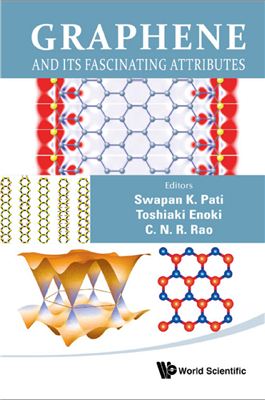World Scientific, 2011. - 287 pp.
Graphene, a single sheet of graphite, has an unconventional electronic structure that can be described in terms of massless Dirac Fermions. This interesting electronic feature is not only an important fundamental issue in condensed matter physics but also holds future promise in post-Si electronic/spintronics device applications. Graphene is the most fundamental building block, with which a variety of carbon-based materials such as graphite, fullerene and carbon nanotubes can be created. The diverse chemical, electronic and magnetic properties of nanographene and graphene are mainly due to their geometrical electronic structure. This book presents the frontiers of graphene research ranging from important issues in condensed matter physics and chemistry to advanced device applications.
Contents:
Graphene: Synthesis, Functionalization and Properties
Synthesis and Characterization of Exfoliated Graphene- and Graphene Oxide-Based Composites
Singlet Open-Shell Character of Polyperiacenes
Doping of Graphene: A Computational Study
Vibrations and Buckling of Uni-Axially Strained Graphene and BN-Monolayer: A First-Principles Study
Raman Spectroscopy of Graphene Edges
Probing Single and Bilayer Graphene Field Effect Transistors by Raman Spectroscopy
Phonons and Electron-Phonon Interaction in Graphene and Nanotube
Magnetic Structures of Edge-State Spins in Nanographene and a Network of Nanographene Sheets
Electronic and Transport Properties of Graphene Nanoribbons
Gate-Voltage Modulation in Graphene
Kondo Physics in Graphene
Noise in Graphene Transistors
Spin Transport in Single- and Multi-Layer Graphene
Quantum Complexity in Graphene
Graphene, a single sheet of graphite, has an unconventional electronic structure that can be described in terms of massless Dirac Fermions. This interesting electronic feature is not only an important fundamental issue in condensed matter physics but also holds future promise in post-Si electronic/spintronics device applications. Graphene is the most fundamental building block, with which a variety of carbon-based materials such as graphite, fullerene and carbon nanotubes can be created. The diverse chemical, electronic and magnetic properties of nanographene and graphene are mainly due to their geometrical electronic structure. This book presents the frontiers of graphene research ranging from important issues in condensed matter physics and chemistry to advanced device applications.
Contents:
Graphene: Synthesis, Functionalization and Properties
Synthesis and Characterization of Exfoliated Graphene- and Graphene Oxide-Based Composites
Singlet Open-Shell Character of Polyperiacenes
Doping of Graphene: A Computational Study
Vibrations and Buckling of Uni-Axially Strained Graphene and BN-Monolayer: A First-Principles Study
Raman Spectroscopy of Graphene Edges
Probing Single and Bilayer Graphene Field Effect Transistors by Raman Spectroscopy
Phonons and Electron-Phonon Interaction in Graphene and Nanotube
Magnetic Structures of Edge-State Spins in Nanographene and a Network of Nanographene Sheets
Electronic and Transport Properties of Graphene Nanoribbons
Gate-Voltage Modulation in Graphene
Kondo Physics in Graphene
Noise in Graphene Transistors
Spin Transport in Single- and Multi-Layer Graphene
Quantum Complexity in Graphene

